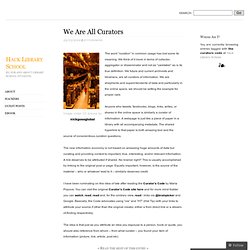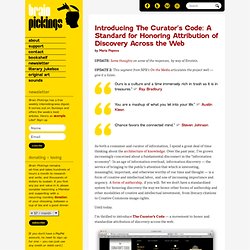

Real-Time News Curation - The Complete Guide Part 6: The Tools Universe. Real-Time News Curation: Part 6 - The Tools and Technologies In this part of the guide you will find: 1.

A Brief History of News Curation Tools 2. The 15 Basic Traits of a News / Content Curation System 3. 4. 5. "I've spent a good deal of time searching for a word other than "Curation" in part because of the connection to museums (which I feared sounded elitist and historic). 1) A Brief History of News Curation Tools The first news curation tools that I am aware of came out in late 2004 - early 2005, reflecting from the very beginning a growing need for both small publishers as well as for medium and large content publishers to be able to aggregate, filter and manually re-order and select the specific content items to be published in a news channel. MySyndicaat, whose parent company, Kipcast has now grown into a multi-faceted service providing advanced news aggregation and republishing widgets for online brands and media companies, has been the true pioneer of this space.
B. filter and 1. 2. Aggregation and curation: two concepts that explain a lot about digital change. Aggregation and curation: two concepts that explain a lot about digital change Every time I read a story about why newspapers are failing that doesn’t mention the role of aggregation and curation in their troubles, it reminds me that something very fundamental is being missed, even by very sophisticated observers.

Aggregation is one of the core concepts of content presentation and commercialization. Any analysis of what happened to the record business, what is happening to newspapers, or the future of books and bookstores and magazines and TV that does not feature this concept prominently is almost certainly flawed. Aggregation, of course, simply means pulling together things which are not necessarily connected. Curation is a term that has always referred to the careful selection and pruning of aggregates, such as for a museum or an art exhibition. NOcontent makes its way from its creator to the public without aggregation. Newspapers are obviously aggregators and curators. 1. 2. 3. The Curator's Code. The curators code. The word “curation” in common usage has lost some its meaning.

We think of it more in terms of collector, aggregator or disseminator and not as “caretaker” as is its true definition. We future and current archivists and librarians, are all curators of information. We are shepherds and superintendents of data and particularly in the online space, we should be setting the example for proper care. Anyone who tweets, facebooks, blogs, links, writes, or shares in the online space is similarly a curator of information. A webpage is just like a piece of paper in a library with all accompanying metadata. The new information economy is not based on amassing huge amounts of data but curating and providing context to important, true, interesting, and/or relevant information. I have been ruminating on this idea of late after reading the Curator’s Code by Maria Popova. . « Read the rest of this entry » Like this:
Curator's ǝpoɔ. Introducing The Curator's Code: A Standard for Honoring Attribution of Discovery Across the Web. By Maria Popova UPDATE: Some thoughts on some of the responses, by way of Einstein.

UPDATE 2: This segment from NPR’s On the Media articulates the project well — give it a listen. Ours is a culture and a time immensely rich in trash as it is in treasures.” ~ Ray Bradbury You are a mashup of what you let into your life.” ~ Austin Kleon Chance favors the connected mind.” ~ Steven Johnson As both a consumer and curator of information, I spend a great deal of time thinking about the architecture of knowledge. Until today. I’m thrilled to introduce The Curator’s Code — a movement to honor and standardize attribution of discovery across the web. One of the most magical things about the Internet is that it’s a whimsical rabbit hole of discovery — we start somewhere familiar and click our way to a wonderland of curiosity and fascination we never knew existed. In both cases, just like the words “via” and “HT,” the respective unicode character would be followed by the actual hotlink to your source.